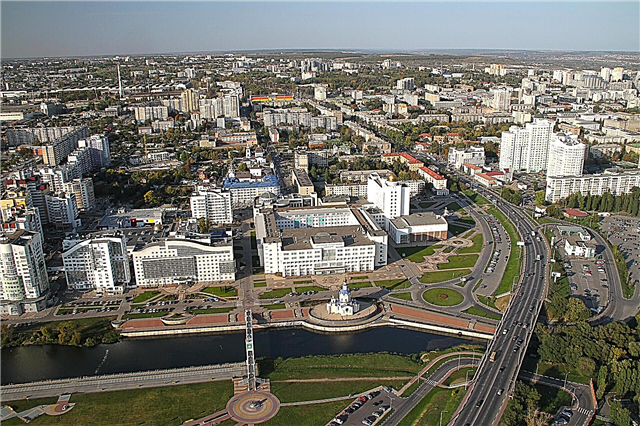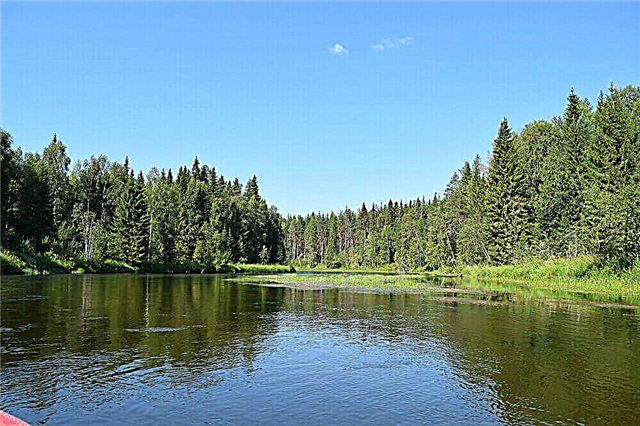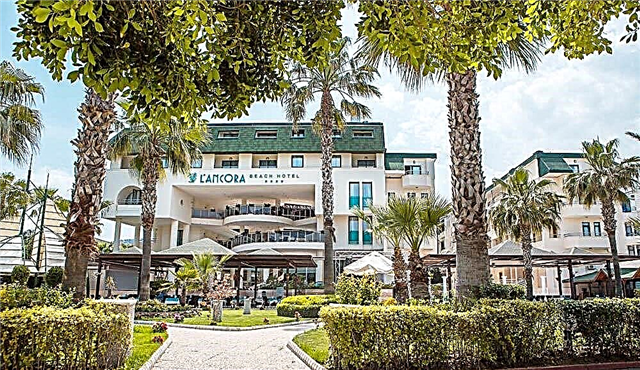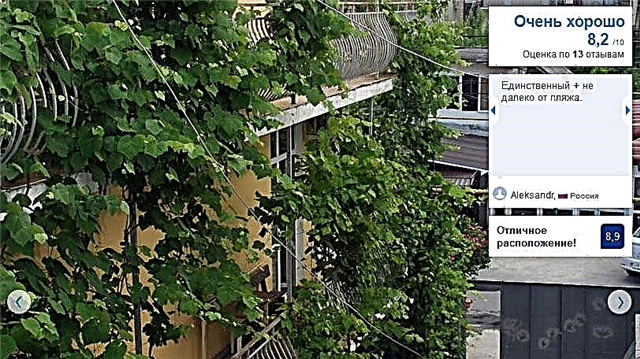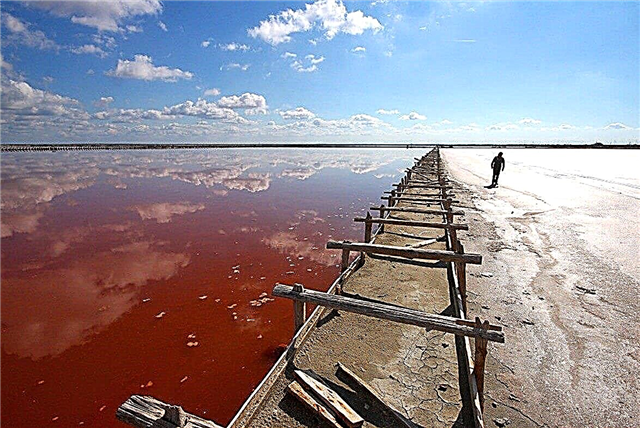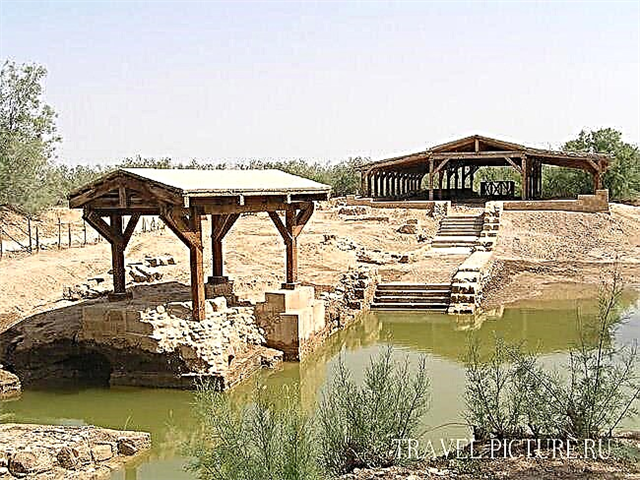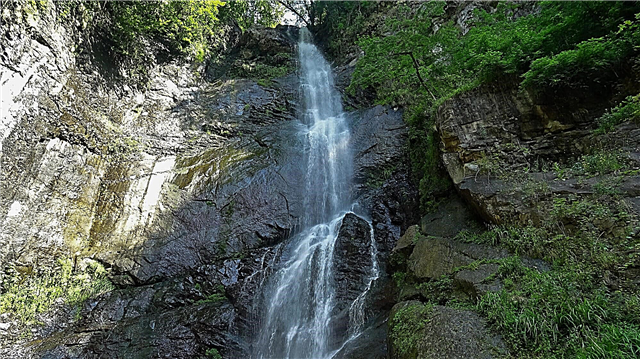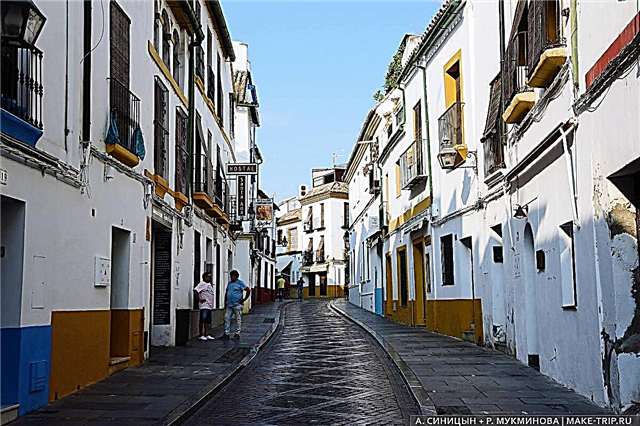To all lovers of a cloudless piercing blue sky, bright oranges, a lazy afternoon nap and oriental flavor, we recommend our guide to sultry beauty - Andalusia.
Our route in Andalusia
The inspirations of travel are Jim Jarmusch's film The Limits of Control and Washington Irving's book The Alhambra. So from the collaboration of Jarmusch and Irving the route Madrid - Seville - Granada - Cordoba - Madrid was born.
When is the best time to go
"You have to be crazy to go to Andalusia in August" - so I thought when choosing hotels in Spain. The Gismeteo website promised heat: + 35 ... + 40 ° С, sunny, no precipitation. But we survived in August and September in Morocco - and even felt comfortable!
Andalusia is called the frying pan of Europe. In summer it is really very hot here - the sun starts to bake actively already at 10 am, and the coolness subsides only after 8 pm. From 14 to 17 o'clock - a real gas chamber! It's siesta time when cities are dying out. We do not recommend walking, it is better to settle in a restaurant and eat menu del dia... The busiest time is from 8 pm to 11 pm, when both locals and tourists pour out into the streets: they socialize, walk, shop, eat tapas and drink beer or wine.

The best time to travel to Andalusia if you can't stand the heat is Spring and fallwhen you can walk comfortably and not huddle up against the walls, protecting yourself from the sun. In the summer, after lunch, it is better to settle in an air-conditioned room or return to the hotel. However, we didn’t regret at all that we went to Andalusia in the hottest season - this is probably the best way to get to know the character of the region and the way of life of the locals.


The nuances of choosing a hotel
In Spain, summer is high season, so book your hotels in advance. Since our trip came up suddenly, the choice of accommodation was limited. If you want a good hotel at a low price, you will have to delve into the reviews and descriptions. I must say right away that all the inexpensive options that were left 2 weeks before the trip did not suit us - we had to exceed the budget. Check out 10 ways to book your hotel cheaper.
Remark: By "good hotel" I mean a standard double room or apartment with a private bathroom and air conditioning, a good location and a rating of 7 on Booking.
On average, in summer, good hotels in the city center cost from € 30 per day. On weekends, prices jump - this is especially noticeable in resorts, for example, in Almeria.
This is where we lived:
- Seville - AACR Hotel Monteolivos 3 *.
- Granada - Abadía Hotel 2 *, Students XD and Allegro Granada 4 *.
- Cordoba - Hesperia Córdoba 4 *.
I share tips for choosing a home. In many hotels:
- Poor soundproofing. If silence is important, stay away from the bars and tourist streets. Or look for new modern hotels near the historic center, rather than hotels in the Old Town of almost medieval buildings. Another option is to choose a room with windows facing the courtyard, but this will not save you from noisy neighbors.
- Small room area in budget B & Bs and hostels: pensión, hostal, hospederia, albergue. Usually it is 9-15 sq. m, and windows often overlook the patio or neighboring houses.
- Lack of parking (or it is paid).
- There is no central heating. Air conditioners are not individual. It may not be available in inexpensive hotels.

How to get around the region
Transport is doing well - the cities are connected by trains and buses. Flights are also possible, but unprofitable - prices are high, and a lot of time is spent. The cost of transport tickets was unexpectedly high.
Route planner. Our go-to wand on a self-guided journey through Andalusia - the GoEuro website. It is convenient to connect routes there, and it is in Russian.
Where to buy tickets. Buying on GoEuro is not always cheap - for example, tickets for ALSA buses are twice as expensive there. But in the case of Renfe trains, the prices are the same, while the GoEuro interface is more user-friendly. However, we advise you to ALWAYS check the prices on the official websites of the carriers.

Bus ticket prices. Prices depend on distance, time of purchase, sometimes the comfort of the bus and travel time. We used the services of two carriers - Socibus and ALSA.
Here prices on the one man:
- Madrid - Seville - 25 euros;
- Seville - Granada - 11 euros;
- Granada - Cordoba - 8-15 euros.
ALSA. Tickets on their website alsa.es need to be bought at least three days before the trip - this is half the price (and cheaper than on GoEuro). There are sales. The highest prices are for Premium buses. It is not necessary to print the ticket, you can show it from your phone.
Socibus. Tickets on the socibus.es website cost the same as on GoEuro. You don't have to print.
Backpacks are required by drivers to be checked in baggage, even if there are fragile things - such a rule. We put the equipment in a bag and took it to the salon, and handed over our backpacks.
The cost of train tickets. Prices depend on the type of train, distance, travel time and time of purchase. We traveled on the route Cordova - Madrid on a high-speed train 160 km / h), the ticket cost 40 euros - we bought it a month. The same ticket costs 60 euros 1 day before the trip, 30 euros for three months.

Rent a Car. Transport tickets are not cheap, and if you plan to travel around Andalusia on your own and see the famous white villages, it is more profitable to rent a car. The most budgetary one is 20 euros per day.
We planned to take an economy car for 3 days with full insurance in Granada for 110 euros: 60 euros for a car + full insurance for 50 euros. Add to this the cost of gasoline and paid parking (15-20 euros per day, and sometimes even higher). There are few free parking lots, so try to find a place in old towns with narrow streets! As a result, the heat and siesta prevailed - we abandoned the idea of renting and moved by bus. Find out more about car rental in Spain.
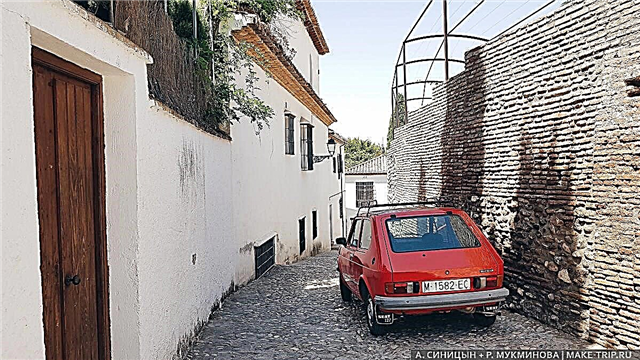
For gourmets: what to try in Andalusia
Jamon, paella, tapas and gazpacho are the main Spanish dishes and can be found on almost any menu. However, in Andalusia, we advise you to choose the food that is traditional for the region. Here are some of the main dishes:
- Salmorejo (salmorejo) - cold soup made from tomatoes, bread, butter, garlic and vinegar. Decorated on top with slices of ham and boiled eggs. What you need in the middle of a siesta! The soup was born in Cordoba, there is even Salmorejo Street.
- Flamenkin (flamenquín) is also a dish from Cordoba. It looks like a cordon blue. This is a jamon wrapped in a thin pork fillet, boneless in breading and egg and deep fried. There are variations with sausage and cheese.
- Fried fish (pescado frito, or pescaito frito) in flour. Served as tapas for wine.
- Gazpacho in Andalusian (gazpacho). In fact, the difference with the gazpacho in Madrid or Barcelona was not noticed.
- Braised oxtail (Rabo de Toro).
- Achoblanco (ajoblanco / ajo blanco) - a kind of white garlic gazpacho. Prepared in Granada, Malaga, Extremadura.

From drinks we advise you to try, in addition to the common tinto de verano (tinto de verano) and sangriadivinely delicious orange wine (vino de naranja) - we drank it in Seville. You can buy a bottle at El Cortes Ingles supermarkets. And, of course, sherry and vermouth - where is without them in Andalusia?
Advice for gourmets and the thrifty... Buy fresh mussels and shrimp from supermarkets and cook them yourself. A kilogram of mussels costs only 2-4 euros, shrimp - 8-12 euros. Also buy a bottle of wine or cider, bread, parsley and lemon. For little money, you can have a fantastic feast! Boil the mussels in their own juice (without adding water and salt!) With a bunch of parsley.

Andalusia attractions map
Andalusia landmarks
What to see in Seville
We arrived in the city without preparation. What I knew about Seville: there is a fortress, the Guadalquivir River, praised by poets, a beautiful tower from the movie "Limits of Control" and an old bridge.
If you have a few days for the city, you can not plan anything in advance and deal with the sights on the spot - hotels give free maps. If it's only 1-2 days, I advise you to make a route.
So, here's what to see in the most beautiful city of Andalusia:
Barrio Santa Cruz and Old Town
These quarters are our favorite walking places, we spent almost all our time here. A real labyrinth of neat shady streets with colorful houses. Photogenic tiles and doors, picturesque balconies and inviting patios, squares with orange trees and babbling fountains, cozy cafes and restaurants. It's nice to walk there for a siesta - although it is hot, there are few tourists and locals.


Seville Alcazar
A palace from an oriental fairy tale with openwork arches, chic ceilings and a royal garden is much more beautiful than the famous Alhambra. Tickets at the box office cost 11.5 euros. In the morning, get ready to stand in a huge queue, after 13 o'clock it becomes five times smaller. You can buy tickets on the official website of the Alcazar for 12.5 euros and skip the line. If you buy for close dates, then tickets for the morning hours may be sold out. Allow 3-4 hours for a visit, or even more.



Cathedral
Entrance - 9 euros. I read that on Monday from 16:30 to 18:00 admission is free. However, in reality, everything is closed, and confused tourists are walking around. We didn't get there.

Isabella II bridge, promenade and Torre del Oro tower
On the bridge you can go to the Triana quarter, but the bridge itself is nothing interesting. The Torre del Oro tower houses the Naval Museum. Admission is free on Mondays.
Triana quarter and Betis street
An unpopulated quarter with picturesque houses during the day. The area is considered trendy and bohemian. The promenade offers a good view of the Torre del Oro tower.

Metropol parasol
Have you seen these futuristic chanterelles made of wood and concrete in the middle of the city? You can go upstairs for 3 euros or wander downstairs for free.
Plaza de España and Maria Luisa Park
The widespread appearance of Plaza de España inspired fears that everything would not be so beautiful in reality. Don't be afraid - the square is beautiful! Parque de María Luisa adjoins the square and is picturesque and shady.

What to see in Granada
With Granada it turned out like with Seville - I knew only about the Alhambra, the Old City of Albaycín and the Sacromonte Abbey. We lived in the city for 15 days and felt almost local.
Albaysin
The old town with winding streets will amaze you with mirador views, details, white houses and views of the Alhambra. You can walk endlessly. In summer, it is best until 10 am, before the heat starts and there are no tourists. The most popular view of the fortress is Mirador San Nicolás, there are always a lot of people there. If you want to enjoy the evening Alhambra, know that you are not the only ones - at dusk the maximum concentration of tourists is on San Nicolas.


Alhambra
The fortress glorified by Irving is mega-popular, and it is besieged by tourists every day - that's why there is no charm in it. However, it is beautiful, and if you are crazy about openwork arches, ceramic tiles, gardens and fortress walls, be sure to go. Buy tickets 1-2 months in advance on the official website of the Alhambra.



Sacromonte
A gypsy area where residents built cuevas directly in the rock. An authentic location, and the views of the Alhambra, Generalife and Albaycín are amazing. You can visit the Museo Cuevas, or the residential house-museum, where the hostess cooks and receives tourists while the children sleep (Casa Cuevas, € 1).

Jewish quarter
The main points are Plaza del Realejo, Santo Domingo church, calle Navas and Casa de los Tiros. In fact, we advise you to just walk around the block, and then go to Corral del Carbon - a 14th century caravanserai, the oldest monument left by the Arabs on the peninsula. Outside is a beautiful arch, inside is a Spartan-looking patio and a museum. They start up for free.
Cathedral
They did not go inside, they admired the outside. A curious view of it opens from the Museum of Modern Art, which is opposite (admission is free).

What to see in Cordoba
Three cultures coexisted in the city for a long time - Christian, Moorish and Jewish. This multiculturalism distinguishes Cordoba from the rest of the cities of Andalusia.
On the city's tourist website, you can download a PDF file with the listed monuments and museums of the city: they upload a document every month with up-to-date schedules, prices, addresses, opening hours and free visiting hours. Very handy for route planning!
Mesquite
A wonderful architectural monument with complex metamorphoses: Roman temple → Visigoth basilica → mosque → Catholic cathedral. It is here that the famous forest of Moorish columns and arches is located. Here the mosque smoothly turns into a Catholic cathedral, and then back into a mosque! From Monday to Saturday from 8:30 am to 9:30 am, admission is free (on normal days - € 10). We advise you to save money - for a free hour you will have time to see everything.


Alcazar and Royal Mews
The fortress of Christian kings disappointed us - it does not cost 4.5 euros. Inside there are gardens, a tower, Arab baths and the fortress itself. We advise, if possible, to pass for free - they are allowed on Thursdays from 12 to 14:30. But the stables were unexpectedly interesting for the free exhibition of carriages!

Jewish Quarter (Juderia)
Jews lived here peacefully from the 10th to the 14th century. It is curious that the quarter is Jewish, but there are also Moorish motives. Next door is the Arab market. By the way, the only synagogue in Andalusia has survived here. The quarter is sandwiched between the Alcazar, the fortress wall with the gates of Almodovar and the episcopal palace. This is a popular tourist destination with cafes and souvenir shops.

Arab streets
The narrow streets ending in small squares with flowers and a fountain are typical examples of the Moorish city layout. There are not many such dead-end alleys in the city - we advise you to look into some: Calleja del Pañuelo, Calleja de las Flores, Calleja de la Hoguera.

Patio and Quarter San Basilio
Cordoba is famous for its patio festival, which takes place in the first half of May. At this time, all the secret gardens of the city are open to tourists. But at other times, you can look into the courtyards - in the same document on the city's website there are several cherished addresses. Most are in the San Basilio quarter. Even if the patios are closed, we advise you to take a walk around the block - it is quiet and picturesque.

Arab Baths
Nothing special: ruins and reconstruction, the film is shown.
Museum of the Inquisition
Small but creepy museum with torture instruments and their detailed descriptions and even drawings. I do not advise gentle natures, on a full stomach - too. Entrance - 3 euros.
Roman temple
Excavations are underway in the middle of a busy street. You can stumble upon just walking.

Useful links
Here are a few sites and services that have helped to plan an independent trip to Andalusia:
- goeuro.com - buying transport tickets.
- Skycsanner Hotels and Booking.com - hotel reservations.
- Aviasales and Skyscanner - booking air tickets.
- Maps.me - detailed maps.
- Rentalcars.com - car rental in Andalusia.
- turismodecordoba.org - Cordoba's tourist site with transport timetables, city maps and other useful tourist information.
- tickets.alhambra-patronato.es - The Alhambra's site for sightseeing information and online ticket purchases.
- ProDict RU-ES is a good Russian-Spanish dictionary for Android.
- CityMapper is a handy Madrid trip planner for Android.
- Moovit is a transport app for Android.


